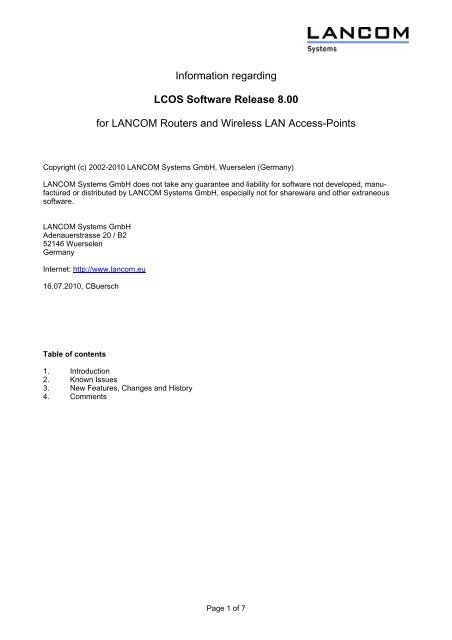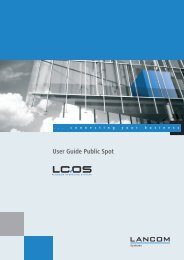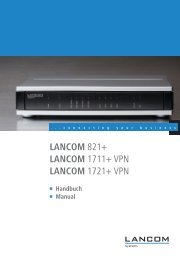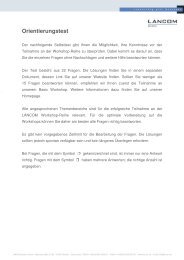Information regarding LCOS Software Release 8.00 for LANCOM ...
Information regarding LCOS Software Release 8.00 for LANCOM ...
Information regarding LCOS Software Release 8.00 for LANCOM ...
You also want an ePaper? Increase the reach of your titles
YUMPU automatically turns print PDFs into web optimized ePapers that Google loves.
<strong>In<strong>for</strong>mation</strong> <strong>regarding</strong><br />
<strong>LCOS</strong> <strong>Software</strong> <strong>Release</strong> <strong>8.00</strong><br />
<strong>for</strong> <strong>LANCOM</strong> Routers and Wireless LAN Access-Points<br />
Copyright (c) 2002-2010 <strong>LANCOM</strong> Systems GmbH, Wuerselen (Germany)<br />
<strong>LANCOM</strong> Systems GmbH does not take any guarantee and liability <strong>for</strong> software not developed, manufactured<br />
or distributed by <strong>LANCOM</strong> Systems GmbH, especially not <strong>for</strong> shareware and other extraneous<br />
software.<br />
<strong>LANCOM</strong> Systems GmbH<br />
Adenauerstrasse 20 / B2<br />
52146 Wuerselen<br />
Germany<br />
Internet: http://www.lancom.eu<br />
16.07.2010, CBuersch<br />
Table of contents<br />
1. Introduction<br />
2. Known Issues<br />
3. New Features, Changes and History<br />
4. Comments<br />
Page 1 of 7
1. Introduction<br />
<strong>LCOS</strong> („<strong>LANCOM</strong> Operating System“) is the operating system <strong>for</strong> all Wireless LAN Access Points and<br />
Routers. In the context of the hardware given by the products the at a time latest <strong>LCOS</strong> version is available<br />
<strong>for</strong> all <strong>LANCOM</strong> products and is available free of charge <strong>for</strong> dowload from <strong>LANCOM</strong> Systems.<br />
This document describes the innovations within <strong>LCOS</strong> software release <strong>8.00</strong>, as well as the changes since<br />
release 7.82<br />
Warning Hint – Backing up the current configuration<br />
Be<strong>for</strong>e upgrading the firmware to <strong>LCOS</strong> <strong>8.00</strong> it is essential to backup the configuration of your router.<br />
Due to extensive features it is not possible to downgrade to a previous firmware without using the<br />
backup configuration.<br />
Please see the reference manual <strong>for</strong> instructions on how to backup the router configuration.<br />
If you want to upgrade devices which are only accessible via router connections or WLAN bridges,<br />
please keep in mind to upgrade the remote device first and the local device afterwards.<br />
Note when updating Central Site Components<br />
We strongly recommend updating productive systems only after internal tests in client environment.<br />
Despite intense internal and external quality assurance procedures possibly not all risks can be<br />
eliminated by <strong>LANCOM</strong> Systems.<br />
Note when using managed Access Points<br />
Prior to managing a <strong>LANCOM</strong> accesspoint using a WLAN controller, you have to upgrade your<br />
access point with the latest converter. The corresponding converter file can be found in your<br />
device’s download directory on the <strong>LANCOM</strong> homepage. The converter upload is similar to a<br />
firmware upgrade.<br />
Note when using certificates<br />
Prior to loading certificates into the <strong>LANCOM</strong> you must install the current converter. The appropriate<br />
converter file can be found in your device’s download directory on the <strong>LANCOM</strong> homepage. Flashing<br />
the converter file works similar to a firmware upgrade.<br />
Note when using converter firmwares<br />
You will need enough free memory to use a firmware 6.0 and newer in your <strong>LANCOM</strong> 15x1, 1611+,<br />
821+ and DSL/I-10+, as well as <strong>for</strong> <strong>LCOS</strong> 8.0 in a <strong>LANCOM</strong> XAC or <strong>LANCOM</strong> 1823 VoIP.<br />
Due to the implementation of several new features within the current build of the firmware, it is no<br />
longer possible to store two main firmware versions side by side. To gain more free space <strong>for</strong> the<br />
current version, it is now necessary to upload a converter firmware into your device. The converterfirmware<br />
has a much smaller size, so that it is now possible to store the main release of the firmware<br />
besides the converter-firmware.<br />
This setup is only necessary once <strong>for</strong> a single device and is done with the so-called converterfirmware<br />
(see readme.pdf of the affected devices).<br />
After having flashed the converter-firmware the firmsave function of the <strong>LANCOM</strong> device is available<br />
only on a limited scale. The update to a newer firmware is furthermore possible. However, in case of<br />
an update failure the <strong>LANCOM</strong> will only work with a minimal-firmware which allows just local access<br />
to the device. Any extended functionality, in particular remote administration, is not possible when<br />
running the minimal-firmware.<br />
Page 2 of 7
Note on Dynamic VPN registration<br />
By reason of patent you have to register the functionality „Dynamic VPN“ with IP address<br />
transmission over ISDN. This operating mode is usually required when you configure a VPN tunnel<br />
with dynamic IP addresses on both sides without dynamic DNS services.<br />
Any other Dynamic VPN operation mode (e.g. transmitting the IP address via ICMP, provoking a<br />
callback etc.) does not require registration.<br />
The registration process is fully anonymous - no personal or company data will be transmitted.<br />
The registration of the Dynamic VPN option requires administrator rights on the <strong>LANCOM</strong> device.<br />
Registration with LANconfig<br />
When scanning the device (e.g. right after program start) LANconfig automatically recognizes<br />
devices which have to be activated. After confirming the arising hint LANconfig automatically<br />
transmits solely the device’s serial number to the <strong>LANCOM</strong> Systems registration server. The<br />
registration code is automatically transmitted back, thus the option will be activated. The state of this<br />
procedure is visible in LANconfig.<br />
Registration with WEBconfig<br />
For the registration with WEBconfig the serial number of the device is required. You can find this<br />
in<strong>for</strong>mation on the bottom of your device.<br />
Using WEBconfig you will find a link on the first page which leads you to the <strong>LANCOM</strong> Systems<br />
registration server. Here you must enter your device’s serial number and -optional- your e-mail<br />
address. After transmitting the data you will receive a registration code <strong>for</strong> the option.<br />
To load this code into your device, please proceed as follows:<br />
Log in to the device with administrator rights. Select “Enable <strong>Software</strong> Option”, which is placed on<br />
the entry page. On the following page enter the registration code and confirm by selecting “Apply”.<br />
Remarks <strong>regarding</strong> the usage of VoIP options<br />
VoIP options <strong>for</strong> <strong>LANCOM</strong> 1821 Wireless ADSL are dicontinued with <strong>LCOS</strong> 7.20. The final version<br />
containing the VoIP Call Manager is <strong>LCOS</strong> 6.32.<br />
As from <strong>LCOS</strong> 7.5x support <strong>for</strong> VoIP options <strong>for</strong> the devices <strong>LANCOM</strong> 1511 Wireless DSL and 1521<br />
Wireless ADSL is discontinued. The final version containing the VoIP Call Manager is <strong>LCOS</strong> 7.30.<br />
For the „VoIP ready“ routers <strong>LANCOM</strong> 1711 VPN, 1721 VPN and 1811 Wireless DSL support <strong>for</strong> the<br />
subsequently installed VoIP option will be discontinued with <strong>LCOS</strong> version 7.56. If you want to<br />
continue using your VoIP option, please do only use <strong>LCOS</strong> versions up to and including 7.54.<br />
For T-Systems Business LAN R800+ VoIP functionality is discontinued in <strong>LCOS</strong> 7.60<br />
<strong>LCOS</strong> 7.70 is the final version supporting VoIP options <strong>for</strong> the remaining „VoIP ready“ devices.<br />
Note when updating a WLAN controller<br />
As from <strong>LCOS</strong> version 8.0 the WLAN controller uses PKCS#12 files <strong>for</strong> managing CA certificates.<br />
If, after updating to the current <strong>LCOS</strong> version, all existing certificates are renewed, they will be stored<br />
in the new PKCS#12 <strong>for</strong>mat automatically.<br />
If an <strong>LCOS</strong> version prior to 8.0 (which does not use the new <strong>for</strong>mat) should be uploaded to the WLC<br />
afterwards, all certificates will be lost, which leads to malfunction of WLC clusters and no<br />
communication with the accesspoints.<br />
There<strong>for</strong>e you should store your active certificates to a safe place be<strong>for</strong>e upgrading your device to<br />
the current <strong>LCOS</strong> version. You can find a how-to description in the reference manual under<br />
"Wireless LAN - WLAN -> Centralized WLAN Management -> Backing up the certificates ".<br />
Page 3 of 7
Remark <strong>for</strong> device specific support of the current <strong>LCOS</strong> version<br />
<strong>LCOS</strong> <strong>8.00</strong> does no longer support the following devices:<br />
- <strong>LANCOM</strong> 1511 Wireless<br />
- <strong>LANCOM</strong> 1521 ADSL Wireless<br />
- <strong>LANCOM</strong> 821 ADSL/ISDN<br />
- <strong>LANCOM</strong> 1610 VPN<br />
- <strong>LANCOM</strong> 1611 Office<br />
- <strong>LANCOM</strong> 1620 VPN<br />
- <strong>LANCOM</strong> 1621 ADSL/ISDN<br />
- <strong>LANCOM</strong> 7011 VPN<br />
- <strong>LANCOM</strong> 3050/3550 Wireless<br />
2. Known Issues<br />
Latest support notes and known issues <strong>regarding</strong> the current <strong>LCOS</strong> version can be found in the download<br />
area of our website http://www.lancom-systems.eu/Common-Support-Hints.64.0.html<br />
3. New features, Changes and History<br />
<strong>LCOS</strong> changes <strong>8.00</strong>.0162 <strong>Release</strong> -> <strong>8.00</strong>.0173 RU1 (only <strong>for</strong> WLC)<br />
Bugfixes / Changes:<br />
WLAN:<br />
- Fixed <strong>LCOS</strong> watchdog when finishing the Public-Spot wizard<br />
- Fixed an <strong>LCOS</strong> watchdog when using background scan<br />
- Fixed an <strong>LCOS</strong> watchdog when activating Public Spot user authentication <strong>for</strong> the interfaces<br />
- Fixed an <strong>LCOS</strong> watchdog when using Public Spot on the LAN-1 interface<br />
Network Connectivity:<br />
- Fixed an <strong>LCOS</strong> watchdog in the automatic ISDN protocol recognition<br />
- Corrected allocation to the ISDN lines <strong>for</strong> outgoing ISDN calls<br />
- VDSL access can be selected in the WEBconfig internet wizard<br />
- ARF networks can be propagated locally via RIP<br />
- No filtering of data packets from RAS clients which got an IP address from the configured WAN pool<br />
- The content filter of the HTTP proxy reports adequate status codes to the http client <strong>for</strong> block- and<br />
errorpages<br />
- Improved configuration of contetntfilter whitelists in WEBconfig<br />
- On portscans, port 0 is no longer reported as open<br />
- On ADSL- and ISDN line errors the error display is deleted not until the connection could be<br />
reestablished. Unnecessary condition changes are avoided (e.g. in LANmonitor)<br />
Page 4 of 7
<strong>LCOS</strong> changes <strong>8.00</strong>.0149 RC2 -> <strong>8.00</strong>.0162 <strong>Release</strong><br />
Bugfixes / Changes:<br />
WLAN:<br />
- WLAN channel selection is no longer set to „automatic“ in WEBconfig<br />
- WLAN data LED showing data traffic on L-32x<br />
- Authenticating to a Public Spot can be used with external authentication sites again<br />
- WEBconfig’s Public Spot wizard opens the voucher popup window without HTTP error message<br />
- In a VLAN environment a new accesspoint regains its controller after having received a new <strong>LCOS</strong><br />
version from it<br />
Network Connectivity:<br />
- Corrected spreading of outgiong ISDN calls to the ISDN lines<br />
- Partitioned data storage mediums connected to the USB port do not hinder <strong>LCOS</strong> boot<br />
- Aborted outgoing calls be<strong>for</strong>e establishment do no longer prevent further calls<br />
- RIP learned routes are processed faster and need less CPU ressources<br />
- The „show script“ command shows the last handled script even repeatedly<br />
- A configuration can be uploaded via TFTP, even with active VLANs<br />
- Netmasks of host addresses can be configured with the IP network table again<br />
- With activated IPsec over HTTPS * port 443 is always open, even if configuration via HTTPS is<br />
disabled<br />
- Corrected routing tag assignment <strong>for</strong> internal TCP services<br />
- TCP connections are no longer cut when modifying firewall rules<br />
<strong>LCOS</strong> changes <strong>8.00</strong>.0124 RC1 -> <strong>8.00</strong>.0149 RC2<br />
Bugfixes / Changes:<br />
WLAN:<br />
- New accesspoints can be assigned to a profile in the WLC using a wizard<br />
- Support <strong>for</strong> DFS (ETSI 301 893 v1.5) <strong>for</strong> radar pulse detection<br />
Network Connectivity:<br />
- Manual rule creation was customized <strong>for</strong> the case the remote station gets an IP address from the<br />
network which is configured as target network in the firewall<br />
- A monitoring job checks the UMTS module of the <strong>LANCOM</strong> 1751 UMTS and resets it if it does not<br />
report all necessary COM ports<br />
- Correct masquerading of VPN packets, if the <strong>LANCOM</strong> was configured as config mode client<br />
- A configuration can be uploaded to a password-free <strong>LANCOM</strong> without errors even if a password is still<br />
set in LANconfig<br />
- If the VPN gateway is part of the remote network, the VPN tunnel can be established without<br />
configuring a particular host route <strong>for</strong> the VPN gateway<br />
- Corrected detection of the index column of an SNMP table<br />
- <strong>LCOS</strong> can be uploaded to devices which are not registered <strong>for</strong> VPN<br />
- Telnet/SSH client can be used with TACACS+<br />
- SNMPwalk does no longer skip columns<br />
- Necessary firewall rules are created when updating the content filter<br />
- The USB interface supports partitioned data storage mediums (FAT) <strong>for</strong> automatic loading of <strong>LCOS</strong><br />
files, configuration data, scripts and <strong>for</strong> the HTTP fileserver<br />
- Accelerated configuration upload via USB<br />
- Reworked per<strong>for</strong>mance statistics output <strong>for</strong> the content filter<br />
* based on NCP VPN Path Finder technology<br />
Page 5 of 7
<strong>LCOS</strong> changes 7.82.0020 <strong>Release</strong> -> <strong>8.00</strong>.0124 RC1<br />
New Features:<br />
WLAN:<br />
- Loadbalancing functionality <strong>for</strong> WLAN controllers, too<br />
- Accesspoint channel load can be monitored via WLC<br />
- New consistent MIB <strong>for</strong> <strong>LANCOM</strong> L-32x series and Wireless LAN controllers, which can be obtained<br />
via <strong>LANCOM</strong><br />
- RADIUS accounting per WLAN-SSID and configuration of the SSID assignment per WLAN controller<br />
Network Connectivity:<br />
- With IPsec over HTTPS * VPN packets are encapsulated in SSL<br />
- Implementation of the Content Filter (optional <strong>for</strong> appropriate router models)<br />
- The <strong>LANCOM</strong> device sends an early message be<strong>for</strong>e a license expires<br />
- Alternative boot configurations can be stored in the <strong>LANCOM</strong><br />
- Implementation of telnet- and SSH clients with new function right in the admin table<br />
- Support <strong>for</strong> USB memory devices <strong>for</strong> USB setup, Public Spot- and Content Filter option (lodging of<br />
HTML documents)<br />
- Automatic <strong>LCOS</strong>- and configuration upload from USB memory devices (USB setup)<br />
- Files on a <strong>LANCOM</strong>-mounted USB stick can be used by the internal http server<br />
- The bootlog is saved compressed to memory<br />
- An alternative DHCP server can be specified <strong>for</strong> DHCP <strong>for</strong>warding<br />
Bugfixes / Changes:<br />
WLAN:<br />
- WLC-communicated fixed IP addresses and VLAN settings are completely adopted, even if the<br />
management VLAN is not 1<br />
Network Connectivity:<br />
- IP addresses are shown correctly in firewall logs<br />
- An appropriate timeserver can be added in WEBconfig<br />
- No ARP requests are sent <strong>for</strong> non-configured gateways (IP: 0.0.0.0) in the IP parameter list<br />
- A cancelled telnet session does no longer deny access<br />
- Checksums are displayed correctly in the VPN packet trace<br />
- Incoming PPTP connections can be established using DNS names<br />
- A RADIUS authentication can happen through a PPTP tunnel<br />
- Incoming PPTP connections are logged to PPTP statistics only after successful connection<br />
establishment<br />
- The PublicSpot wizard does no longer lead to an <strong>LCOS</strong> watchdog.<br />
- Simplified Dial-In using certificates can be used with tagged default routes, too<br />
- The Public Spot Wizard can be set as function right in the administrator table<br />
* based on NCP VPN Path Finder technology<br />
Page 6 of 7
4. Comments<br />
If you want to upgrade the firmware of your device to a new version, please install the latest LANtools first.<br />
Be<strong>for</strong>e running the firmware-upload you should save the router configuration to a file. After that you<br />
can use LANconfig to load the latest <strong>LCOS</strong>-version into the device.<br />
In principle, we suggest upgrading the firmware of your device only if you are in need of the latest features.<br />
Please note that different firmware files might be available <strong>for</strong> your device. Further in<strong>for</strong>mation can be found<br />
in the file README.PDF in the download area of our homepage.<br />
Page 7 of 7







